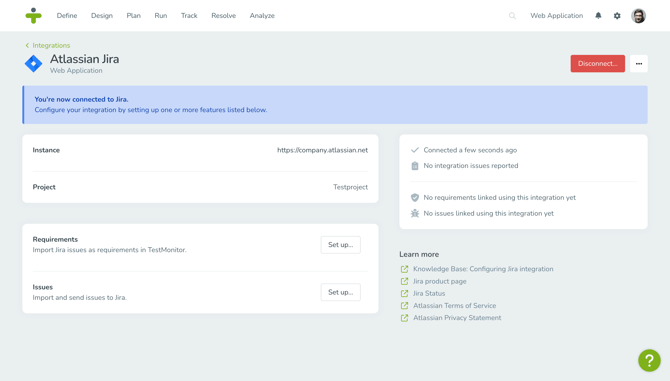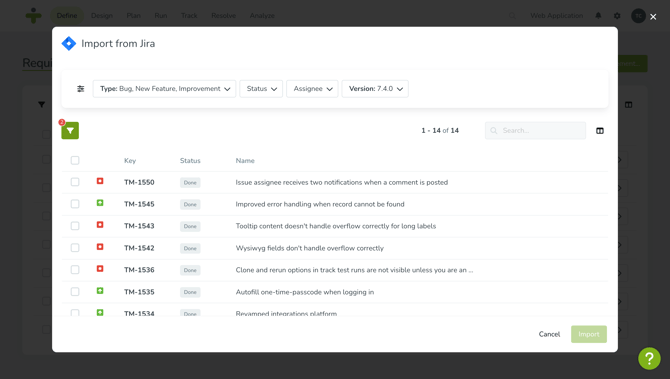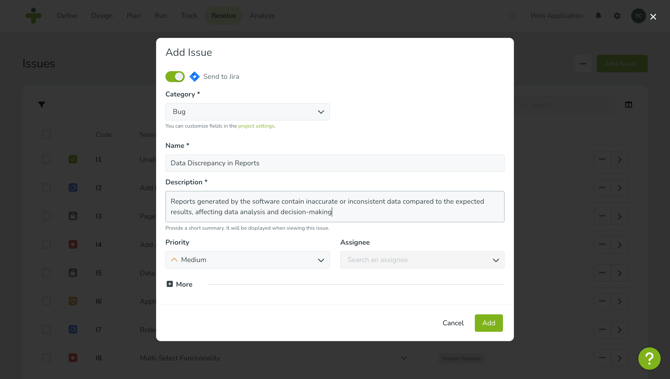Jira
The Jira integration streamlines project management, importing issues for test case design and enabling sending and synchronization of TestMonitor issues.

The Jira integration with TestMonitor offers an effective project management solution by allowing teams to import Jira issues as requirements, enabling thorough test case design. Additionally, sending TestMonitor issues to Jira creates a clear feedback loop for quick issue resolution and improved project transparency.
About Jira
Jira is a powerful project management tool that helps teams organize tasks, track issues, and manage workflows efficiently through customizable boards and workflows. It's widely used for agile development, allowing teams to plan, track, and release software effectively.
Features
Here's a list of features available for the Jira integration:
- Send TestMonitor issues to Jira
- Link existing Jira issues to issues in TestMonitor
- Link existing Jira issues to requirements in TestMonitor
- Synchronize issue status from Jira
- Import Jira issues as requirements in TestMonitor
- Import issues from Jira
Two-way sync is only available when subscribed to a Professional or Enterprise plan.
Prerequisites
Before you can use this integration, make sure that you meet these requirements:
- You must either be a admin or have the project manager role in TestMonitor.
- You have an active Atlassian account.
- This account has permissions for issue management (create and update issues).
- This account has permissions for managing projects (create webhooks for two-way sync).
- A project is set up in Jira.
When all these requirements are met, you can proceed with connecting to Jira.
Please note that only Jira Cloud is supported, as Atlassian has discontinued support for Jira Server products.
Connect to Jira
Go to the Project Settings of the project you wish to set up an integration with. Once you have opened the project settings page:
- Head over to the Integrations section and click on the Jira panel.
- In the top right corner, click on Connect. The connection wizard appears.
- Click on Authenticate. You'll be redirected to Atlassian (if you're not signed in with your Atlassian account, now is the time to authenticate).
- Confirm the permissions TestMonitor requires by clicking Accept. You'll be redirected back to TestMonitor.
- When authentication is successful, click on Next in the connection wizard to proceed.
- Select your Jira instance and project.
- Click on Finish to complete the connection wizard.

You're now ready set up one or more features this integration has to offer.
Import issues from Jira
Importing issues from Jira provides the flexibility to create them as requirements or issues within TestMonitor. This process enhances efficiency by eliminating the need for manual imports and exports, while also establishing a seamless connection between Jira and TestMonitor.
Import issues as requirements
Importing issues as requirements kickstarts your test project by effortlessly transferring them from Jira into TestMonitor, allowing you to efficiently create test cases and ensure alignment with your project objectives.

To enable this feature, first, make sure you're connected to Jira. Then, follow these steps to configure the import feature:
- In the Requirements panel, click on Set up...
- Enable the Import requirements option in the first page of the wizard and proceed to the next step.
- Either enable Import Jira types to automatically create custom requirement types for Jira types or select a Default type for imports. Click Confirm to proceed.
- Click Finish to activate the Import requirements feature.
When enabled, head over to your project's requirements to start importing issues:
- In the top-right corner, click on Import from Jira. The Jira issue browser will open.
- Select one or more issues by clicking on the checkboxes on the left side. You can use both the filters as well as the search feature to narrow down the list.
- Once you've selected the issues you want to import, click on Import to proceed.
TestMonitor will import the selected issues as requirements.
The name and description of the Jira issue will be utilized when importing requirements. Please note that certain formatting options in the description may not be preserved due to variations in formatting support.
Access to the Status filter requires the "Administer projects" permission.
Import Jira issues as TestMonitor issues
Efficiently copy the issues from Jira to compile a comprehensive list of all your issues, readily accessible in TestMonitor. This allows you to create test cases and confirm their resolution with ease.
To enable this feature, first, make sure you're connected to Jira. Then, follow these steps to configure the import feature:
- In the Issues panel:
- If you haven't configured the issues feature yet, click on Set up...
- When you've already configured the feature: click on Configure.
- Enable the Import issues option in the first page of the wizard and proceed to the next step.
- Enter your preferred options for the status and category fields by specifying the Default status and Default category. Click Next to proceed.
- Proceed through the remaining steps until you reach the final step.
- Click Finish to activate the Import issues feature.
When enabled, head over to your project's issues to start importing issues:
- In the top-right corner, click on Import from Jira. The Jira issue browser will open.
- Select one or more issues by clicking on the checkboxes on the left side. You can use both the filters as well as the search feature to narrow down the list.
- Once you've selected the issue you want to import, click on Import to proceed.
Send issues to Jira
Sending issues to Jira from TestMonitor ensures swift resolution, while two-way status sync keeps TestMonitor updated, enabling you to retest and close any resolved issues.

To enable this feature, first, make sure you're connected to Jira. Then, follow these steps to configure the send issues feature:
- In the Issues panel:
- If you haven't configured the issues feature yet, click on Set up...
- When you've already configured the feature: click on Configure.
- Enable the Send issues option in the first page of the wizard.
- Proceed to the Send step and configure the options:
- Default issue type: This type will be used when creating a Jira issue.
- Send by default: Enables the Send to Jira toggle as a default.
- Proceed to the Synchronize step and configure two-way sync:
- Two-way sync: Enables two-way status sync between TestMonitor and Jira.
- Mapping: Align the Jira statuses with the TestMonitor statuses. If you choose the "Don't assign" option, TestMonitor will ignore Jira updates to this status.
- Proceed to the Confirm step and click Finish to activate the Send issues feature.
You are now ready to send issues to Jira.
Two-way sync is only available when subscribed to a Professional or Enterprise plan.
Send new issues to Jira
Once the Send issues feature has been enabled, you can send new TestMonitor issues directly to Jira. Head over to your project's issue management and follow these instructions:
- Click the Add Issue... button.
- Fill in the issue's details.
- Enable the Send to Jira toggle.
- Click Create to confirm.
Once the process is complete, your issue will be created and sent to Jira. Within the issue overview, a small Jira badge will display the Jira issue code alongside the issue, serving as a direct link to the corresponding Jira page. Simply click on the badge to navigate directly to the Jira page for further details on the issue.
The Jira issue's name will be aligned with TestMonitor, and the description will include the following details:
- Description (TestMonitor)
- Status
- Priority
- Category
- Assignee
- Custom fields (and their values)
Send existing issues to Jira
You can send issues already present in TestMonitor by following these instructions:
- Open the issue's detail page.
- In the top-right corner, click on the Jira logo. A dropdown menu will appear.
- Click on Send to Jira.
Once the procedure has been completed, your issue will be successfully sent to Jira and linked to the corresponding TestMonitor issue.
Link Jira issues to TestMonitor
If you already have an issue in Jira that needs to be linked to its corresponding TestMonitor counterpart, follow these steps:
- Open the issue's detail page.
- In the top-right corner, click on the Jira logo. A dropdown menu will appear.
- Click on Link to Jira.
- In the dropdown field, select the Jira issue you want to link.
- Click on Link to confirm.
Once the process is complete, your issue will be linked to Jira.
Unlink issues from Jira
If you have mistakenly linked the incorrect issue or simply wish to unlink the issue, you can follow these steps:
- Open the issue's detail page.
- In the top-right corner, click on the Jira logo. A dropdown menu will appear.
- Click on Unlink from Jira.
- Confirm your action by clicking Unlink.
Once the process is finished, the connection with Jira will be removed.
Disconnect the Jira Integration
If the integration is no longer required or your project comes to an end you can easily disconnect the integration.To disconnect the integration, go to the Project Settings of the integration's project and follow these steps:
- Head over to the Integrations section and click on the Jira panel.
- In the top right corner, click on Disconnect....
- Click Disconnect to confirm.
By disconnecting the integration, all links between Jira and TestMonitor will be permanently removed. However, please note that the issues in TestMonitor and Jira will remain unaffected by this action.
Troubleshooting
If you encounter errors involving the Jira integration with TestMonitor, here are some steps you can take to troubleshoot the issue:
Inspect the integration log
The integration log assists in identifying the reasons for integration failures by listing all encountered issues while interacting with Jira. To access the log, follow these instructions:
- Open the integration page
- Click on the link in the right panel that reports the number of integration issues.
Investigate the log entry by reviewing the error type and description. You can dismiss the error by clicking on the check button on the right.
Dealing with Jira workflows
In Jira, workflows are the paths issues follow from creation to completion, consisting of statuses and transitions that represent work processes within your organization.
When 2-way sync is enabled in TestMonitor, these workflows may restrict specific status changes. Despite an active workflow that prevents users from directly closing issues, TestMonitor does not have the same limitation and will try to modify the status regardless. This will cause the issue status to be out-of-sync; also, a log entry will be recorded in the integration's log.
To prevent out-of-sync issues, you might want to consider one of these options:
- Adjust the workflow to be more flexible, allowing for additional status transitions.
- For the status field, prioritize mapping important status values and utilize the "Don't assign" option for other values. This allows TestMonitor to skip updating those specific statuses and reduces the risk of running into out-of-sync problems.
Re-enable the integration
If an integration fails due to a communication error or glitch, re-enabling it on the integration page may resolve the issue. Test importing or sending a test object to ensure proper functionality.
Re-authenticate the integration
Your integration may have become disabled due to an authentication error. This could occur if the credentials used for authentication have expired or become invalid.- Click on the three-dotted menu in the top-right corner.
- Select Re-authenticate...
- Confirm your action and provide your credentials when asked.
- Check if the problem persists by either importing or sending a test object.
Contact support
If these solutions do not resolve your issue, feel free to reach out to our support team for additional assistance.